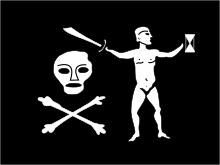Jean Thomas Dulaien
Jean Thomas Dulaien (fl. 1727-1728, last name also Dulaiën or du Lain) was a French pirate active in the Caribbean. He is known for preserved copies of his Articles (pirate code) and black flag.
Jean Thomas Dulaien | |
|---|---|
 Possible design of Jean Dulaien's flag, also often attributed to pirate Walter Kennedy. | |
| Died | 1704 |
| Nationality | French |
| Other names | Dulaiën |
| Occupation | Pirate |
| Years active | 1727-1728 |
| Known for | Preserved copies of his Articles (pirate code) and black flag |
| Piratical career | |
| Other names | du Lain |
| Base of operations | Caribbean |
| Commands | Sans Pitie |
History
Born in 1704, Dulaien received a respectable education in France and was a licensed ship's pilot.[1] By 1727 he was aboard a privateer ship in the Caribbean, cruising against the English with a mixed Spanish and French crew. The French crewmen mutinied, massacring the Spaniards and electing Dulaien as captain. They renamed the ship Sans Pitie (Merciless).[2]
The crew agreed to a shared set of Articles for governing behavior aboard ship. Like other pirate codes, there were provisions for punishing sailors who deserted, hid loot, argued, or were derelict in their duties. They also allowed for compensation for injured sailors, and appointed a lieutenant to monitor cargo aboard captured ships. Dulaien's Articles forbade killing prisoners, except notably, the Spanish.[2] Unlike most pirate articles, Dulaien's specified when they would give quarter: if a ship resisted after seeing their black flag, they would raise a red flag, and if the victim fired at least three cannon shots afterwards, the pirates would spare no one.[3]
Dulaien hid his 60-ton, 14-gun ship among the tall trees on the shores of West Caicos.[1] They quickly captured over a dozen ships – some of them French – and kept the best for their flotilla, keeping others for careening the Sans Pitie. Dulaien appointed an associate named Garnier to command his consort ship, renamed Sans Quartier (No Quarter). Within a year they decided to divide their plunder and return to France to seek a pardon. Dropping off most of his crew on Tortuga, he prepared to leave for Nantes. Reportedly Dulaien said to the surprised crew of the Sans Quartier as he sailed away with most of their treasure, “Goodbye! Farewell, scoundrels! I go to France and I am no longer a pirate.”[2] Before accepting the pardon, Dulaien and his crew sold their looted goods and hid their treasure, leaving some with friends and relatives.[4]
French officials had offered a pardon on the condition that Dulaien turn over any stolen goods. They suspected there was far more than the little plunder they found on the Sans Pitie, and convinced local priests to threaten excommunication for citizens who aided the pirates. The threat worked, and after they discovered the hidden treasure, they arrested Dulaien and the crew.[2] The Sans Pitie was in poor condition and was sold off to help pay merchants whose cargo Dulaien had looted. After appeals to the King the crew were released. Dulaien was left in jail for some time longer, though his ultimate fate is not known.[3]
.svg.png)
Jolly Roger
Dulaien's pirate flag was described by the mayor of Nantes as “black cloth, with white designs of human figures, cutlasses, bones, and hourglasses.”[2] A woodblock purportedly made from a drawing of the flag has survived, as have other independent drawings of Dulaien's flag. The original flag itself was preserved for some years, possibly later destroyed on orders from King Louis XV.[5] His flag is often confused with that of Walter Kennedy, which was described in similar terms. Because the original flag is missing and the extant drawings do not entirely agree, the actual flag's design is not known with certainty.[3]
See also
- Montigny la Palisse – Another French pirate active late in the Golden Age of Piracy.
References
- Ossian, Rob. "Jean Thomas Dulaien". www.thepirateking.com. Retrieved 28 September 2017.
- Vignols, Léon (1890). La piraterie sur l'Atlantique au XVIIIe siècle (in French) (French ed.). Paris: Typographie Oberthur. Retrieved 28 September 2017.
- Little, Benerson (2016). The Golden Age of Piracy: The Truth Behind Pirate Myths. New York: Skyhorse Publishing, Inc. ISBN 9781510713048. Retrieved 28 September 2017.
- Little, Benerson (2005). The Sea Rover's Practice: Pirate Tactics and Techniques, 1630-1730. Washington DC: Potomac Books, Inc. p. 201. ISBN 9781574889109. Retrieved 28 September 2017.
- Little, Benerson. "THE GOLDEN AGE OF PIRACY: The Truth Behind Pirate Myths - Benerson Little". www.benersonlittle.com. Retrieved 28 September 2017.
